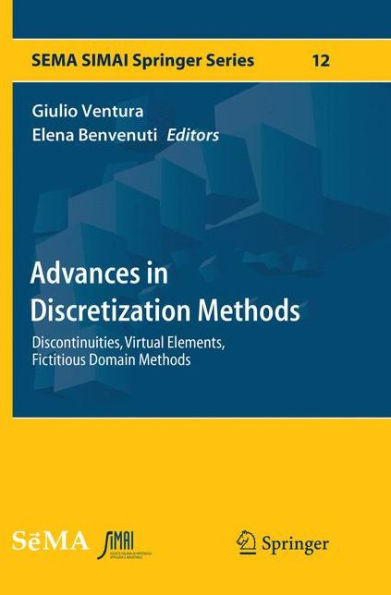Advances in Discretization Methods: Discontinuities, Virtual Elements, Fictitious Domain Methods
This book gathers selected contributions on emerging research work presented at the International Conference eXtended Discretization MethodS (X-DMS), held in Ferrara in September 2015. It highlights the most relevant advances made at the international level in the context of expanding classical discretization methods, like finite elements, to the numerical analysis of a variety of physical problems. The improvements are intended to achieve higher computational efficiency and to account for special features of the solution directly in the approximation space and/or in the discretization procedure. The methods described include, among others, partition of unity methods (meshfree, XFEM, GFEM), virtual element methods, fictitious domain methods, and special techniques for static and evolving interfaces. The uniting feature of all contributions is the direct link between computational methodologies and their application to different engineering areas.
1133673877
Advances in Discretization Methods: Discontinuities, Virtual Elements, Fictitious Domain Methods
This book gathers selected contributions on emerging research work presented at the International Conference eXtended Discretization MethodS (X-DMS), held in Ferrara in September 2015. It highlights the most relevant advances made at the international level in the context of expanding classical discretization methods, like finite elements, to the numerical analysis of a variety of physical problems. The improvements are intended to achieve higher computational efficiency and to account for special features of the solution directly in the approximation space and/or in the discretization procedure. The methods described include, among others, partition of unity methods (meshfree, XFEM, GFEM), virtual element methods, fictitious domain methods, and special techniques for static and evolving interfaces. The uniting feature of all contributions is the direct link between computational methodologies and their application to different engineering areas.
109.99
In Stock
5
1

Advances in Discretization Methods: Discontinuities, Virtual Elements, Fictitious Domain Methods
269
Advances in Discretization Methods: Discontinuities, Virtual Elements, Fictitious Domain Methods
269Paperback(Softcover reprint of the original 1st ed. 2016)
$109.99
109.99
In Stock

Product Details
| ISBN-13: | 9783319823065 |
|---|---|
| Publisher: | Springer International Publishing |
| Publication date: | 06/13/2018 |
| Series: | SEMA SIMAI Springer Series , #12 |
| Edition description: | Softcover reprint of the original 1st ed. 2016 |
| Pages: | 269 |
| Product dimensions: | 6.10(w) x 9.25(h) x (d) |
From the B&N Reads Blog
